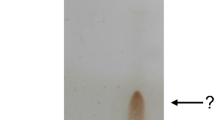Abstract
Direct utilization of palm oil for the simultaneous production of polyhydroxyalkanoates (PHAs) and rhamnolipids was demonstrated using Pseudomonas aeruginosa IFO3924. By secreted lipase, palm oil was hydrolyzed into glycerol and fatty acids. Fatty acids became favorable carbon sources for cell growth and PHA production via β-oxidation and glycerol for rhamnolipid production via de novo fatty acid synthesis. Both PHA and rhamnolipid syntheses started after the nitrogen source was exhausted and cell growth ceased. PHA synthesis continued until all fatty acids were exhausted, and at that time, PHA content in the cells reached a maximum, but stopped despite the remaining glycerol (<2g/l). In contrast, rhamnolipid synthesis continued until glycerol was exhausted.




Similar content being viewed by others
References
Ashby RD, Solaiman DK, Foglia TA (2004) Bacterial poly(hydroxyalkanoate) polymer production from the biodiesel co-product stream. J Polym Environ 12:105–112
Banat IM (1995) Characterization of biosurfactants and their use in pollution removal—state of the art (review). Acta Biotechnol 15:251–267
Braunegg G, Sonnleitner B, Lafferty RM (1978) A rapid gas chromatographic method for the determination of poly(b-hydroxybutyric acid) in microbial biomass. Eur J Appl Microbiol Biotechnol 6:29–37
Casini E, de Rijk TC, de Waard P, Eggink G (1997) Synthesis of poly(hydroxyalkanoate) from hydrolyzed linseed oil. J Environ Polym Degrad 5:153–158
Cromwick AM, Foglia T, Lenz RW (1996) The microbial production of poly(hydroxyalkanoates) from tallow. Appl Microbiol Biotechnol 46:464–469
Fuchtenbusch B, Wullbrandt D, Steinbuchel A (2000) Production of polyhydroxyalkanoic acids by Ralstonia eutropha and Pseudomonas oleovorans from an oil remaining from biotechnological rhamnose production. Appl Microbiol Biotechnol 53:167–172
Fukui T, Doi Y (1998) Efficient production of polyhydroxyalkanoates from plant oils by Alcaligenes euthrophus and its recombinant strain. Appl Microbiol Biotechnol 49:333–336
Hori K, Soga K, Doi Y (1994) Effect of culture conditions on molecular weight of poly(3-hydroxyalkanoates) produced by Pseudomonas putida from octanoate. Biotechnol Lett 16:709–714
Hori K, Marsudi S, Unno H (2002) Simultaneous production of polyhydroxyalkanoates and rhamnolipids by Pseudomonas aeruginosa. Biotechnol Bioeng 78:699–707
Ishigami Y, Gama Y, Uji Y, Masui K, Shibayama Y (1988) Japanese Patent Kokai S63-77535 (Kokoku H5-63219)
Jarvis GN, Thiele JH (1997) Qualitative rhodamine B assay which uses tallow as a substrate for lipolytic obligately anaerobic bacteria. J Microbiol Methods 29:41–47
Kahar P, Tsuge T, Taguchi K, Doi Y (2004) High yield production of polyhydroxyalkanoates from soybean oil by Ralstonia eutropha and its recombinant strain. Polym Degrad Stab 83:79–86
Kessler B, Witholt B (2001) Factors involved in the regulatory network of polyhydroxyalkanoate metabolism. J Biotechnol 86:97–104
Kleckner V, Kosaric N (1993) Biosurfactants for cosmetics. In: Kosaric N (ed) Surfactant science series 48: biosurfactants: production, properties, applications. Marcel Dekker, New York, pp 373–389
Koch AK, Kappeli O, Ficher A, Reiser J (1991) Hydrocarbon assimilation and biosurfactant production in Pseudomonas aeruginosa mutants. J Bacteriol 173:4212–4219
Lang S, Wullbrandt D (1999) Rhamnose lipids-biosynthesis, microbial production and potential application. Appl Microbiol Biotechnol 51:22–32
Majid MIA, Hori K, Akiyama M, Doi Y (1994) Production of Poly(3-hydroxybutyrate) from plant oils by Alcaligenes sp. In: Doi Y, Fukuda K (eds) Biodegradable plastics and polymers. Elsevier, Japan, pp 417–424
Majid MIA, Akmal DH, Few LL, Agustien A, Toh MS, Samian MR, Najimuddin N, Azizan MN (1999) Production of poly(3-hydroxybutyrate) and its copolymer poly(3-hydroxybutyrate-co-3-hydroxyvalerate) by Erwina sp. USMI-20. Int J Biol Macromol 25:95–104
Raiders RA, Knapp RM, McInerney MJ (1989) Microbial selective plugging and enhanced oil recovery. J Ind Microbiol 4:215–230
Rehm BHA, Mitsky TA, Steinbüchel A (2001) Role of fatty acid de novo biosynthesis in polyhydroxyalkanoic acid (PHA) and rhamnolipid synthesis by Pseudomonads: establishment of the transacylase (PhaG)-mediated pathway for PHA biosynthesis in Escherichia coli. Appl Environ Microbiol 67:3102–3109
Solaiman DKY, Ashby RD, Foglia TA (2001) Production of polyhydroxyalkanoates from intact triacylglycerols by genetically engineered Pseudomonas. Appl Microbiol Biotechnol 56:664–669
Sudesh K, Abe H, Doi Y (2000) Synthesis, structure and properties of polyhydroxyalkanoates: Biological polyesters. Prog Polym Sci 25:1503–55
Tan IKP, Kumar KS, Theanmalar M, Gan SN, Gordan B III (1997) Saponified palm kernel oil and its major free fatty acids as carbon substrates for the production of polyhydroxyalknaoates in Psedomonas putida PGA1. Appl Microbiol Biotechnol 47:207–211
Wei YH, Choub CL, Chang JS (2005) Rhamnolipid production by indigenous Pseudomonas aeruginosa J4 originating from petrochemical wastewater. Biochem Eng J 27:146–154
Author information
Authors and Affiliations
Corresponding author
Rights and permissions
About this article
Cite this article
Marsudi, S., Unno, H. & Hori, K. Palm oil utilization for the simultaneous production of polyhydroxyalkanoates and rhamnolipids by Pseudomonas aeruginosa . Appl Microbiol Biotechnol 78, 955–961 (2008). https://doi.org/10.1007/s00253-008-1388-3
Received:
Revised:
Accepted:
Published:
Issue Date:
DOI: https://doi.org/10.1007/s00253-008-1388-3




